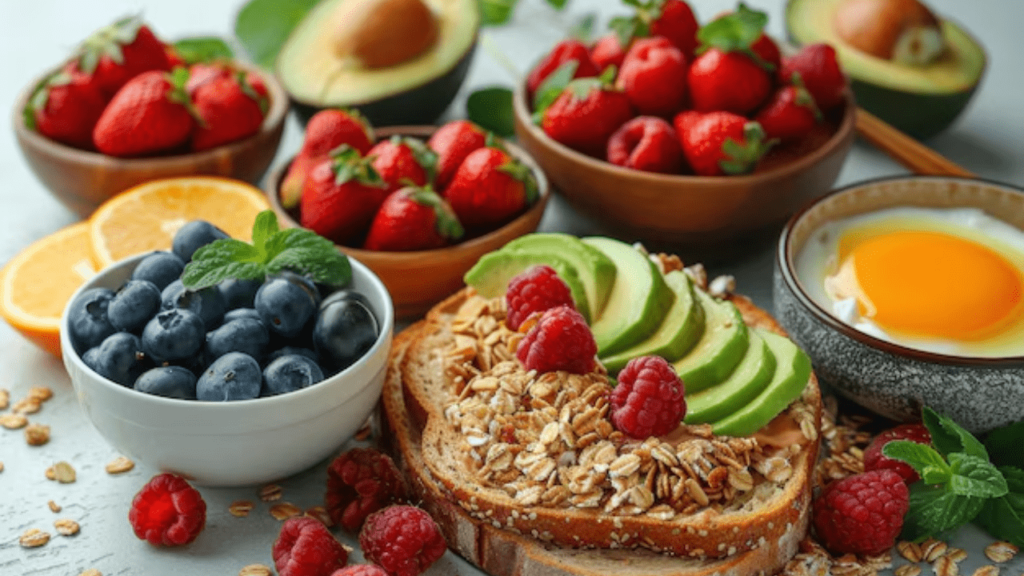Managing blood sugar levels requires a holistic approach that involves more than just dietary changes. Here are 10 superfoods that can be beneficial for maintaining lower blood sugar levels. These foods are not only nutritious but also easy to incorporate into your daily diet.

Maintaining healthy blood sugar levels is vital for overall well-being, especially for individuals managing diabetes or prediabetes. Diet plays a crucial role in this, and certain foods have been proven to help regulate blood sugar levels naturally.
In this comprehensive guide, we explore ten superfoods that can assist in blood sugar management, offering both nutritional insights and practical tips.
1. Seafood
Rich in protein, omega-3 fatty acids, and antioxidants, seafood is excellent for blood sugar control. Fish like salmon, mackerel, and sardines are particularly beneficial due to their high omega-3 content, which can improve insulin sensitivity and reduce inflammation.
Nutritional Benefits:
- Omega-3 fatty acids help lower blood sugar levels.
- High protein content promotes satiety and reduces carbohydrate cravings.
Practical Tips:
- Try to eat seafood that is high in fat twice a week or more.
- Grill, bake, or poach fish to retain its nutritional value without adding unhealthy fats.
2. Nuts and Nut Butters
Nuts like almonds, walnuts, and nut butters are excellent for managing blood sugar levels. They are packed with fiber, healthy fats, and protein, all of which help slow down the absorption of sugar and improve insulin function.
Nutritional Benefits:
- High in monounsaturated fats, which are heart-healthy.
- Fiber content aids in regulating blood sugar.
Practical Tips:
- Snack on a handful of nuts for a quick energy boost.
- Add nut butters to smoothies or use as a dip for fruits and vegetables.
3. Beans and Lentils
Beans and lentils are staples in many diets around the world and for good reason. They are high in protein, fiber, and resistant starch, all of which can help improve blood sugar control.
Nutritional Benefits:
- High in complex carbohydrates that are digested slowly.
- Rich in protein, promoting satiety and reducing blood sugar spikes.
Practical Tips:
- Incorporate beans and lentils into soups, stews, and salads.
- Use them as a meat substitute in dishes to increase fiber intake.
4. Sweet Potatoes
Sweet potatoes have a lower glycemic index than regular potatoes and are rich in fiber and antioxidants. They help stabilize blood sugar levels by slowing down the digestion and absorption of carbohydrates.
Nutritional Benefits:
- High in fiber, which helps regulate blood sugar.
- Contains antioxidants like beta-carotene.
Practical Tips:
- Sweet potatoes provide a nutrient-dense side dish when baked or roasted.
- Use mashed sweet potatoes as a base for soups or casseroles.
5. Greek Yogurt
Probiotics, calcium, and protein are all abundant in Greek yogurt. It has a low glycemic index and can help regulate blood sugar levels by improving gut health and insulin sensitivity.
Nutritional Benefits:
- High in protein, promoting satiety and reducing blood sugar spikes.
- Contains probiotics that support gut health.
Practical Tips:
- Savor Greek yogurt paired with a handful of fresh berries and almonds.
- Use Greek yogurt as a base for smoothies or salad dressings.

6. Leafy Greens
Leafy greens like spinach, kale, and Swiss chard are low in calories and carbohydrates but high in fiber and nutrients. They can enhance general health and assist in lowering blood sugar levels.
Nutritional Benefits:
- High in fiber, which helps with blood sugar regulation and digestion.
- Rich in vitamins A, C, and K, and antioxidants.
Practical Tips:
- Add leafy greens to salads, smoothies, or stir-fries.
- Utilize them as a foundation for stews and soups.
7. Quinoa
Quinoa is a whole grain that is high in protein, fiber, and various essential nutrients. It has a low glycemic index and can help regulate blood sugar levels by slowing down the digestion and absorption of carbohydrates.
Nutritional Benefits:
- High in fiber and protein, promoting satiety and blood sugar control.
- Contains magnesium, which helps improve insulin sensitivity.
Practical Tips:
- Quinoa can be used as a salad basis, bowl filler, or side dish.
- Cook quinoa with vegetables and herbs for a nutritious meal.
8. Citrus Fruits
Citrus fruits like oranges, lemons, and grapefruits are low in carbohydrates and high in fiber, vitamins, and antioxidants. They can help control blood sugar levels and have a low glycemic index.
Nutritional Benefits:
- Rich in soluble fiber, which helps regulate blood sugar.
- Rich in vitamin C and flavonoids, reducing oxidative stress.
Practical Tips:
- Enjoy citrus fruits as a snack or add to salads.
- Use lemon or lime juice as a dressing or flavor enhancer.
9. Pumpkin and Pumpkin Seeds
Pumpkin and its seeds are not only delicious but also beneficial for blood sugar control. Pumpkins are high in fiber and antioxidants, which help lower blood sugar levels. Pumpkin seeds are rich in healthy fats and magnesium, essential for blood sugar regulation.
Nutritional Benefits:
- High fiber content slows glucose absorption.
- Rich in antioxidants, reducing oxidative stress.
Practical Tips:
- Roast pumpkin seeds for a healthy snack.
- Use pumpkin puree in soups, smoothies, or baked goods for added nutrition.
10. Broccoli and Broccoli Sprouts
Broccoli and its sprouts are nutritious powerhouses, rich in beneficial chemicals such as sulforaphane. This antioxidant has been shown to reduce oxidative stress and decrease blood sugar levels. Incorporating broccoli into your diet can be as simple as adding it to salads, stir-fries, or as a steamed side dish.
Nutritional Benefits:
- High in fiber, aiding digestion and slowing glucose absorption.
- Contains vitamins A, C, and K, enhancing overall health.
Practical Tips:
- Steam or roast broccoli for maximum nutrient retention.
- Add broccoli sprouts to sandwiches or smoothies for an extra nutritional boost.
In Short!
Incorporating these ten superfoods into your diet can significantly help manage and lower blood sugar levels naturally. It’s essential to pair these dietary choices with regular physical activity and other healthy lifestyle habits. Always consult with a healthcare professional before making significant changes to your diet, especially if you have underlying health conditions. By embracing these nutritious foods, you can take proactive steps towards better blood sugar control and overall health.
Final Thoughts
Managing blood sugar levels is a holistic process that involves diet, exercise, and lifestyle changes. These ten foods are not just beneficial for blood sugar control but also contribute to overall well-being. By understanding and utilizing the power of nutrition, you can take control of your health in a natural and sustainable way. Start incorporating these foods into your daily meals, and experience the positive changes they bring to your blood sugar levels and overall health.
Read Next:

The Psychology of Love: Why Valentines Day Matters More Epic Than You Think
Discover the psychology of love and why Valentines Day is more important than you think. Learn how love impacts the brain, strengthens relationships, and boosts

Premier League Highlights: Arsenal Humiliate Man City 5-1, Spurs and Palace Secure Crucial Wins
Arsenal demolished Manchester City 5-1 in a statement premier league highlights win, reigniting their title hopes. Meanwhile, Crystal Palace stunned Man United 2-0, and Tottenham

How Budget 2025 Impacts the Indian Middle-Class: Major Tax Benefits and Glaring Omissions
Budget 2025 offers major tax relief to the middle class, including zero tax on incomes up to ₹12 lakh. However, it misses out on incentives

Degrees vs Employability: Why “Highly Qualified Degree Holders” Struggle to Find Jobs While “Less Qualified Individuals” Get Hired Faster!
Many highly qualified individuals struggle to secure jobs, while less qualified candidates get hired quickly. This Degrees vs Employability paradox is caused by employer preferences,

The Power of Mindset: Why Looking Poor Doesn’t Make You Poor, but Thinking Poor Does!
Discover why looking poor doesn’t define your wealth but thinking poor does. Learn the power of mindset and how a growth-oriented mindset can lead to

Overthinking: How It’s Damaging Today’s Youth – Causes and Cure in 2025
Understanding how overthinking is silently damaging today’s youth, from its causes rooted in societal pressure and social media to its long-term effects on mental health.

Netaji Subhash Chandra Bose: An Epitome of Epic Leadership
Discovering the incredible life of Netaji Subhash Chandra Bose, a leader whose vision, courage, and determination redefined India’s freedom struggle. Explore his leadership qualities, ideology,

Global News Headlines Today: From Gaza Ceasefire to Blue Origin’s Massive 2025 Milestone
Explore today’s top global news headlines, from the Gaza ceasefire and Blue Origin’s historic spaceflight to Apple losing its top spot in China’s smartphone market.

The Hidden Danger of Social Media Nudity: A Threat to Today’s Youth in 2025
Understanding how social media nudity is impacting the youth and their future potential. Learn about the risks of unregulated content, cultural sensitivities, and solutions for

FA Cup 2024: Manchester United Survive Arsenal Test to Advance in FA Cup Fourth Round
Manchester United defeated Arsenal in a thrilling FA Cup third-round encounter, with Atlay Bayindir’s heroics sealing the win. Read about key moments, standout performances, and

Supercopa de España: Barcelona Dominate Real Madrid 5-2 to Claim Supercup
Barcelona delivered a stunning 5-2 victory over Real Madrid in the Supercopa de España final. Read about the key moments, star players, and the significance

Global News Highlights Today: India’s Metro Milestone, US Aid Shift, iOS Stunning Updates and More!
Explore today’s global news highlights, including the Tibet earthquake, political tensions in South Korea, LA wildfires, US aid shifts, and India’s metro milestone. Stay informed
